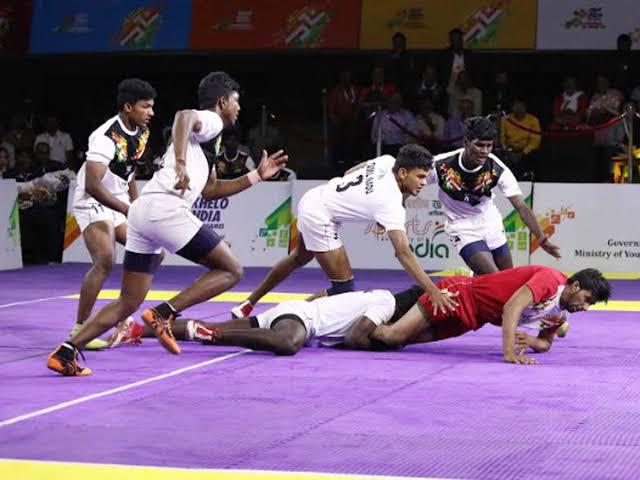
The teep, also known as the push kick, is one of the most versatile weapons in Muay Thai. It’s often called the “jab of the legs” because of how effectively it controls distance, disrupts rhythm, and sets up other strikes.
But the teep isn’t just a defensive tool; when combined with other attacks, it becomes a powerful offensive setup that keeps opponents guessing. Learning how to build teep combinations helps you blend timing, balance, and creativity in every round.
Today, let’s look at six combinations you can use in your next session that can blend smoothly into your Muay Thai game.
1) Teep To Cross
A simple but highly effective combination, the teep to cross teaches you how to transition smoothly from long range to mid-range striking.
Start with a front teep to your opponent’s midsection. As they step back or attempt to close the distance, use the recoil from your kick to plant your foot and immediately throw a cross down the middle.
This works especially well when you’ve established your teep early in the fight, often resulting in your opponents expecting another kick which will often lower their guard, leaving their chin open for your cross
2) Teep To Roundhouse Kick
Few combinations showcase Muay Thai’s fluid power like this one. The teep sets your opponent’s balance off-center, making the follow-up kick land with full force.
Throw a firm teep to the midsection or hip to make your opponent lean back or stumble. As soon as your foot lands, rotate your hips and unleash a roundhouse kick to the ribs or legs. You could also consider taking a step forward and before throwing the round
The trick is in the timing — don’t rush. Let the teep do its job first before following through with controlled power.
3) Feint Teep To Switch Kick
Feinting the teep is a great way to manipulate reactions. Once your opponent starts reading your teep, turning it into a setup makes your offense unpredictable.
Begin as if you’re about to throw a front teep, but instead plant your lead foot lightly and immediately switch stance to fire a powerful kick from the opposite leg.
The feint draws the opponent’s attention downward or backward, creating the perfect window for your kick to land cleanly.
4) Teep To Step-In Elbow
This combination blends range and aggression, ideal for catching opponents who like to rush in.
Throw a teep to the stomach to stop forward pressure. As your opponent moves back or blocks, step forward with your foot and follow up with a tight elbow strike.
It’s an advanced combo that requires timing, but when executed correctly, it turns a defensive motion into a close-range counterattack. Once, you are more familiar with the movement, you can even add in a back elbow.
5) Lead Teep To Body Kick
This combination is perfect for fighters who rely on rhythm and range control.
Use a quick lead teep to measure distance or probe your opponent’s guard. Once you feel their reaction — whether they block or parry — retract and throw a body kick to the opposite side.
It’s a fluid motion that confuses the opponent’s defense, especially when done with consistent rhythm and tempo changes.
Tips For Building Effective Teep Combinations
- Work On Balance And Recovery: Your teep is only as good as your ability to return to stance quickly.
- Vary Your Targets: Mix teeps to the body, thigh, and even the lead arm to keep your opponent guessing.
- Use Feints And Tempo Changes: The teep’s strength lies in unpredictability. Change rhythm to break patterns.
- Drill Slowly First: Precision matters more than power. Build coordination, then add speed.
Frequently Asked Questions (FAQ)
Q: What Is The Main Purpose Of The Teep In Muay Thai?
A: The teep controls distance, interrupts attacks, and creates space for counterstrikes. It can be used defensively to stop forward pressure or offensively to set up combinations.
Q: How Can I Improve My Balance When Using The Teep?
A: Practice slow, controlled teeps with focus on posture and recovery. Keep your supporting foot flat, your core engaged, and always return to stance before following up with another strike.
Q: Can The Teep Be Used For Knockouts?
A: While rare, a powerful teep to the body or solar plexus can end a fight if it lands cleanly. However, it’s most effective as a setup for other strikes rather than a direct knockout tool.
Q: Which Leg Should I Use For The Teep?
A: Both legs can be used. The lead teep is faster and ideal for disrupting rhythm, while the rear teep carries more power and works well for pushing back aggressive opponents.
Q: How Often Should I Practice Teep Combinations?
A: Incorporate teep drills into every session. Repetition builds timing and balance. Start with basic setups, then add movement, feints, and partner drills as you progress.
Q: Why Is The Teep Called The “Jab Of The Legs”?
A: Like a jab in boxing, the teep sets range, breaks rhythm, and opens opportunities for follow-up attacks. It’s a fundamental strike that controls the pace of a fight.
Final Thoughts
The teep is one of the purest expressions of Muay Thai technique — simple, controlled, and endlessly adaptable. When used alone, it stops aggression. When combined, it becomes a gateway to offense.
Mastering teep combinations teaches not just timing and accuracy, but also patience and awareness. The best fighters don’t just throw the teep — they build their entire rhythm around it.
So whether you’re sparring, drilling, or competing, remember: every great combination begins with control, and few tools control a fight better than a well-placed teep.
You may also like:
How To Check Kicks In Muay Thai
Summary The clinch is one of the most dominant positions in Muay Thai, and knowing how to sweep from it can completely change the flow of a fight. A clinch sweep allows you to off-balance…
Summary In Muay Thai, every strike has an answer. For low kicks and body kicks, the answer is the check. This simple yet crucial move can change the flow of a fight, turning an opponent’s…
Summary Sparring isn’t just for fighters who step into the ring. For hobbyists, it’s one of the best ways to truly understand Muay Thai. It teaches timing, defense, and strategy in a way that pad…
Low leg kicks are one of the most under-appreciated weapons in striking arts. They quietly erode an opponent’s mobility, set the pace, and often serve as fight finishers. In Muay Thai, kickboxing, and MMA, a…
Muay Thai is often called the art of eight limbs, combining punches, kicks, elbows, and knees into a complete striking system. Among these weapons, the knee is one of the most powerful and effective tools,…
In combat sports, the way a fighter stands can change everything about how a match unfolds. Stance determines balance, power, and angles of attack. Among the many stances, the southpaw stance is often described as…
Summary Wrestling is one of the most popular martial arts worldwide, and it’s been around as far back as 3000 BC. It’s a grappling-based martial art that focuses on putting your opponent on the ground,…
Summary Strength and conditioning exercises are used to strengthen your muscles and joints, improving your mobility. We all move around the place as we complete our day-to-day obligations, so we all can benefit from making…
Summary Kids who train in martial arts burn a lot of energy, physically and mentally. Good nutrition and smart recovery habits help them stay healthy, focused, and excited for their next class. This guide breaks…
Summary In a fast-paced city like Singapore, stress, fatigue, and burnout often feel like part of daily life. Between long working hours, digital distractions, and limited downtime, many adults are searching for a way to…
Summary You need to learn how to throw punches in bunches if you plan to compete as a boxer. Sure, the first thing you need to focus on when you start boxing training is the…
With the rise of global fitness competitions showcasing athletes from different sports and the recent appearance of Bokh Wrestling Champion Orkhonbayar Bayarsaikhan in Physical Asia, many have started to wonder what Bokh Wrestling is all…


































